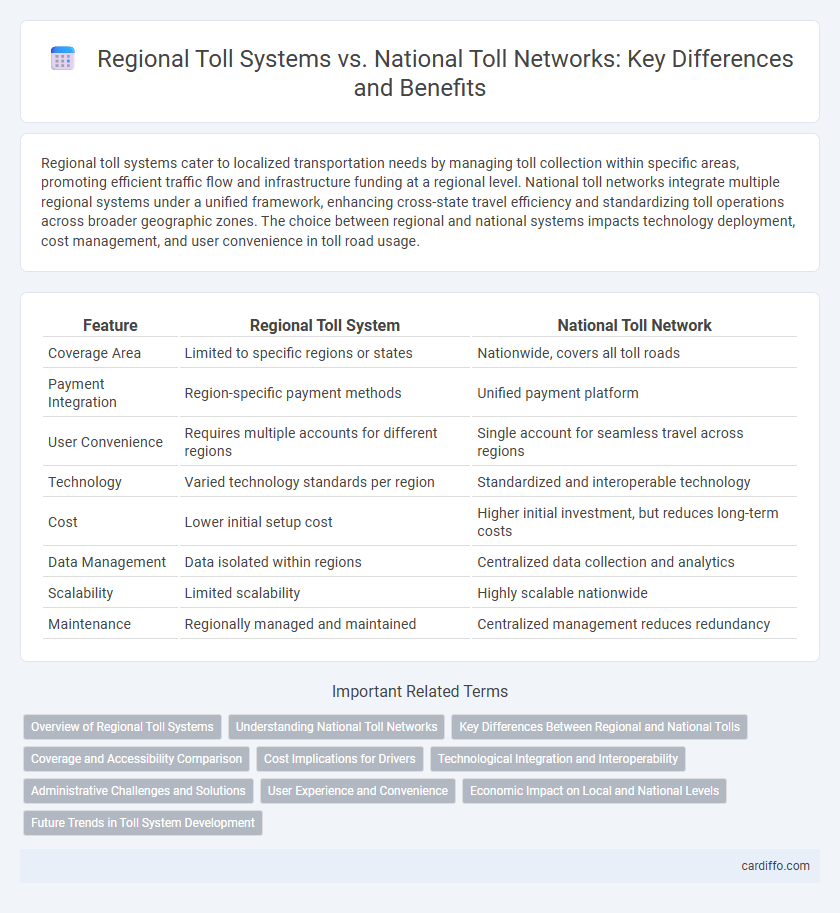Regional toll systems cater to localized transportation needs by managing toll collection within specific areas, promoting efficient traffic flow and infrastructure funding at a regional level. National toll networks integrate multiple regional systems under a unified framework, enhancing cross-state travel efficiency and standardizing toll operations across broader geographic zones. The choice between regional and national systems impacts technology deployment, cost management, and user convenience in toll road usage.
Table of Comparison
| Feature | Regional Toll System | National Toll Network |
|---|---|---|
| Coverage Area | Limited to specific regions or states | Nationwide, covers all toll roads |
| Payment Integration | Region-specific payment methods | Unified payment platform |
| User Convenience | Requires multiple accounts for different regions | Single account for seamless travel across regions |
| Technology | Varied technology standards per region | Standardized and interoperable technology |
| Cost | Lower initial setup cost | Higher initial investment, but reduces long-term costs |
| Data Management | Data isolated within regions | Centralized data collection and analytics |
| Scalability | Limited scalability | Highly scalable nationwide |
| Maintenance | Regionally managed and maintained | Centralized management reduces redundancy |
Overview of Regional Toll Systems
Regional toll systems operate within specific geographic areas, managing toll collection on highways, bridges, and tunnels to fund infrastructure maintenance and improvements. These systems often use localized electronic toll collection technologies such as RFID transponders or license plate recognition tailored to the region's traffic patterns and administrative policies. Unlike national toll networks, regional systems provide more flexibility in pricing structures and can address unique regional transportation needs more effectively.
Understanding National Toll Networks
National toll networks integrate regional toll systems into a unified infrastructure, enabling seamless cross-state travel and efficient toll collection. These networks leverage advanced technologies such as electronic toll collection (ETC) and interoperable payment platforms to reduce congestion and enhance user convenience. Understanding national toll networks requires analyzing their impact on transportation efficiency, revenue distribution, and infrastructure development at a macro level.
Key Differences Between Regional and National Tolls
Regional toll systems operate within specific geographic areas, targeting local traffic and often featuring variable pricing based on time of day or vehicle type. National toll networks cover extensive routes across multiple regions, providing unified toll collection and standardized pricing structures for interstate travel. Key differences include scope of coverage, pricing strategies, and technological integration for toll enforcement and payment processing.
Coverage and Accessibility Comparison
Regional Toll Systems typically cover specific metropolitan areas or zones, offering targeted access primarily within city limits or designated regions, which limits their geographic scope but enhances local traffic management. National Toll Networks provide extensive coverage across multiple states or the entire country, facilitating long-distance travel and interstate commerce with broader accessibility. While regional systems excel in managing local congestion, national networks offer seamless connectivity for diverse vehicle types over extensive routes.
Cost Implications for Drivers
Regional toll systems often result in varying toll fees depending on the state or municipality, which can increase overall travel costs for drivers crossing multiple regions. In contrast, a national toll network standardizes toll pricing and payment methods, reducing administrative expenses and travel delays that contribute to higher fuel consumption and costs. Harmonized tolling systems also enable more efficient route planning and cost prediction, benefiting drivers through transparent and consistent toll charges.
Technological Integration and Interoperability
Regional toll systems often rely on localized technologies that may limit interoperability across different areas, causing challenges for seamless toll collection. National toll networks utilize standardized electronic toll collection (ETC) systems with unified protocols, enabling drivers to use a single device or account nationwide. Enhanced technological integration in national networks supports efficient data sharing, real-time traffic management, and consistent user experience across multiple regions.
Administrative Challenges and Solutions
Regional toll systems often face administrative challenges such as inconsistent toll collection technologies, varied fee structures, and fragmented regulatory oversight, which complicate seamless travel and revenue management. National toll networks address these issues by standardizing toll protocols, integrating interoperable payment systems, and centralizing administrative control to enhance efficiency and reduce operational costs. Implementing unified data management platforms and legislative harmonization further streamlines enforcement and improves user experience across multiple jurisdictions.
User Experience and Convenience
Regional Toll Systems often provide tailored user interfaces and payment options specific to local drivers, enhancing ease of use within confined geographic areas. National Toll Networks streamline travel across state lines by integrating toll payments into a single account or transponder, reducing the need for multiple registrations. Seamless interoperability in national systems significantly improves convenience for frequent long-distance commuters and commercial vehicles.
Economic Impact on Local and National Levels
Regional toll systems generate targeted revenue that supports local infrastructure improvements, enhancing economic activity within specific areas by reducing transport costs and improving connectivity. National toll networks create a unified funding mechanism that enables large-scale infrastructure projects, promoting interstate commerce and stimulating broader economic growth across the country. Both systems influence economic outcomes by balancing localized investment incentives with efficient resource allocation on a national scale.
Future Trends in Toll System Development
Regional Toll Systems are increasingly integrating smart technologies like IoT and AI to enhance traffic flow and reduce congestion, paving the way for more adaptive toll pricing strategies. National Toll Networks focus on standardizing interoperability and data sharing across states to create seamless multimodal transportation corridors. Future trends emphasize the convergence of regional innovations into unified platforms, supporting dynamic tolling and real-time decision-making for efficient infrastructure management.
Regional Toll System vs National Toll Network Infographic

 cardiffo.com
cardiffo.com